International Consulting
Urban Development(Cultural heritage preservation)
Sri Lanka
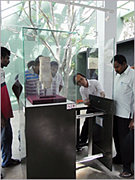 Training in display case maintenance
Training in display case maintenance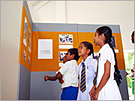 School children visiting the museum
School children visiting the museum
| Title | : | Development of Culture-Oriented Tourism in Sigiriya |
| Period | : | Aubust 2008 – December 2010 |
| Funded by | : | JICA |
Sigiriya, in the Central Province of Sri Lanka, is one of the most important cultural heritage sites located in the heart of the Cultural Triangle formed by joining three major historical capitals of Anuradhapura, Polonnaruwa, and Kandy. As tourism is a vital source of foreign currency for Sri Lanka, Government of Japan has been implementing several tourism promotion programs in Sigiriya and other regions to assist its tourism promotion policy.
This project started as part of such assistance programs and aims at the technical transfer to make the Sigiriya Museum a centerpiece of the region’s tourism industry. The project purpose and expected outputs are as follows.
- Project purpose
- Synergistic enhancement of the museum activities and tourism in the Sigiriya area
- Output 1:
- Establishment and development of functions (Museum operation planning, display designing, facility management etc.) for the new museum
- Output 2:
- Providing information for visitors’ demand about the Sigiriya area
- Output 3:
- Formulation of a tourism promotion and marketing plan for the Sigiriya area and utilization of the plan by relevant organizations
Kokusai Kogyo took part in the preceding grant aid project “the improvement of display equipment of the Sigiriya Museum”.
With their vast experience and archeological expertise, our consultants effectively assisted the capacity development of the two project implementation authorities, the Central Cultural Fund of the Ministry of Cultural Affairs and National Heritage and Sri Lanka Tourism Promotion Bureau (SLTPB) of the Ministry of Tourism.
Lao People’s Democratic Republic
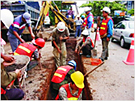 Excavation survey in Laos
Excavation survey in Laos
| Title | : | The Buried Cultural Property Survey on the Project for Improvement of Vientiane No.1 Road |
| Period | : | May 2004 – November 2004 |
| Funded by | : | JICA |
The ASEAN conference was planned in November 2004 in Vientiane, Lao PDR. For the national leaders visiting to enjoy a comfortable stay in Vientiane, the government of Laos requested the government of Japan to improve No.1 Road, which connects the central district of Vientiane with Wattai Airport. During the basic design of the road improvement project, however, it became clear that buried properties in the area would require consideration and preservation, which was the impetus for this project. In the end, the ASEAN conference was held without incident.
Meanwhile, the road implementation project would continue until 2007 or later.
Kokusai Kogyo used a ground-penetrating radar to accurately detect the subsurface archeological artifacts along the 6 kilometer stretch of road, and also carried out a literature review and a survey on the reconstruction history of temples along the road. As a result, we identified 32 spots for test pit excavation. Two consultants from Kokusai Kogyo, four Japanese archaeologists and officials from the Ministry of Information and Culture in Laos jointly carried out the excavation survey, while also paying close attention to rainwater drainage and road traffic control.
A total of 13,779 artifacts were collected. Since it was far more than expected, the post-excavation works required the schedule to be extended. Most of the artifacts were from the Langxane period, but amongst these were artifacts from the Palaeolithic, Neolithic and Mon/Khmer culture.
Based on the result of this survey, the road improvement project was planned to avoid large-scale excavation work whenever possible.
A detailed archaeological study was to be implemented in parallel with the road improvement project, and we estimated the time and cost necessary for the study considering the level of archaeological significance of each section of the road, appropriating higher costs with areas of higher archaeological significance that required more careful study.
China
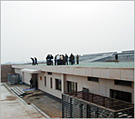 Museum constructed half underground so as to preserve the natural scenery
Museum constructed half underground so as to preserve the natural scenery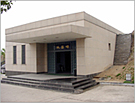 Protective covering for Tang Dynasty kiln remains
Protective covering for Tang Dynasty kiln remains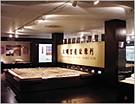 Exhibition of artifacts in the museum
Exhibition of artifacts in the museum
| Title | : | The Project for Improvement of the Surrounding Area of the Hanyuan Hall of the Daming Palace |
| Period | : | March 2002 – November 2003 |
| Funded by | : | Japanese Grant Aid |
Daming Palace, situated in the north of Xian City, was built in 662 during the Tang Dynasty.
The Hanyuan Hall was used by the emperor to hold ceremonies and receive foreign envoys including from Japan and, therefore, has a deep historical connection with Japan. However, the palace was destroyed in the 9th century and only the foundations remain today. Since 1995, preservation and restoration activities on the site have been carried out through the UNESCO/Japan Trust Fund project.
This study designed a protective covering for kiln remains and facilities to display the archeological artifacts collected, in coordination with the preservation and restoration activities, and conducted tendering and supervision of the construction works. We also carried out the selection, tendering and procurement of equipment required for the display, research, and management of artifacts.
Lao People’s Democratic Republic
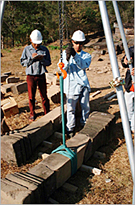 Loa trainees restoring an artifact with the provided equipment
Loa trainees restoring an artifact with the provided equipment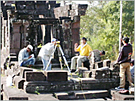 Archeological survey training using the provided equipment
Archeological survey training using the provided equipment Museum for displaying artifacts at Vat Phou
Museum for displaying artifacts at Vat Phou
| Title | : | The Project for the Conservation of Vat Phou Archaeological Site |
| Period | : | May 2001 – March 2003 |
| Funded by | : | Japanese Grant Aid |
In recent years, Laos has been utilizing its abundant natural and cultural assets to promote tourism.
Vat Phou temple, located in Champasak, was built by the Khmers from the 5th to 12th century and is an important legacy of Khmer culture. As there was a need for facilities and equipment to preserve and restore the archeological ruins, in the study we designed drainage facilities, a repository and a fence, and conducted tendering and supervision of the construction works.
We also carried out the selection, tendering and procurement of restoration equipment.
Sort by region
| Geospatial Information | Forestry | Disaster Risk Reduction | Energy |
| Water and Sanitation | Agriculture | Urban Development | Others |
Sort by sector
| Asia | Middle East | Europe | Africa |
| South and Central America | Oceania | Worldwide |

